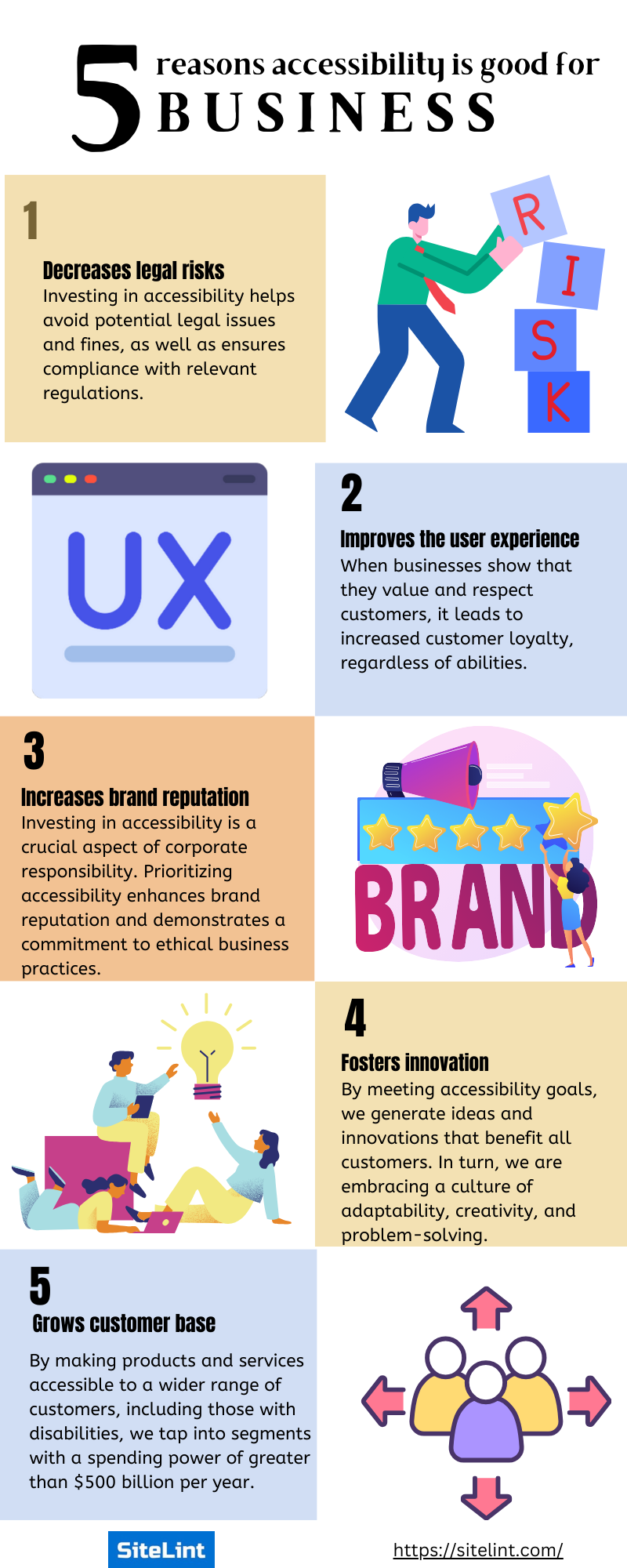Explore the business case for accessibility in this comprehensive article. Discover strategies for making your business more inclusive and profitable.
In the ever-evolving landscape of global business, companies are constantly looking for ways to innovate and expand their market reach as well as to enhance their brand reputation.
On the path to these goals, one vital element that often gets overlooked is accessibility. Accessibility refers to the practice of making products, services, and environments usable by as many people as possible, particularly those with disabilities. However, this notion goes beyond simply ticking legal boxes. Embracing inclusivity and social responsibility isn’t just the right thing to do, it’s a powerful driver of business success.
In the past, businesses may have viewed accessibility as a secondary concern or a regulatory necessity. Nonetheless, this point of view has been rapidly changing. The rise of ethical consumerism, advancements in technology, and increasing awareness around diversity and inclusion have brought accessibility to the forefront of strategic business planning. Integrating accessibility into business operations is no longer about only doing the right thing; it’s now about adopting something transformative that can drive innovation, expand customer bases, and build a stronger brand.
With that said, we will explore five compelling reasons why accessibility is not just good for business, but fundamental for its growth and sustainability. From reducing legal risks to fostering innovation to tapping into the significant spending power of people with disabilities, the case for accessibility in business is strong and multifaceted. Let’s dive into these reasons and understand how accessibility is a key ingredient contributing to modern business success.
Reducing legal risks: Beyond compliance
Compliance with accessibility legislation, such as the Americans with Disabilities Act (ADA) in the U.S. or the Equality Act in the U.K., is often seen as a necessary legal requirement.
However, businesses that proactively embrace accessibility can go beyond mere compliance and significantly reduce the risk of expensive and reputation-damaging lawsuits. In recent years, there has been a rise in litigation related to accessibility, particularly in digital spaces. By prioritizing accessibility from the outset, companies can avoid these legal pitfalls.
Furthermore, being known for compliance can enhance a company’s reputation among government entities, NGOs, and socially conscious investors.
Enhancing user experience: A gateway to universal design
The core principles of accessibility are closely linked to those of universal design, which advocates for creating products and environments that are usable by all people, without adaptation.
Such an approach leads to improvements like simplified navigation, clear labeling, and responsive design that benefits all users, not just those with disabilities. For example, voice-activated systems which were initially designed for users with mobility issues, are now widely popular among the general population.
By focusing on accessibility, businesses can improve the user experience for their entire customer base, leading to higher satisfaction rates, increased loyalty, and more active word-of-mouth marketing.
Boosting brand reputation: Aligning with ethical consumerism
In an era where consumers are increasingly making choices based on social and ethical considerations, a commitment to accessibility will substantially enhance a brand’s reputation.
Companies that are seen as inclusive and socially responsible often experience greater consumer trust and loyalty. For example, when a business actively works to make its environment and services accessible, it’s often viewed as empathetic and forward-thinking. Such perception is often a differentiator in competitive markets. Additionally, it attracts socially conscious employees, creating a more engaged and diverse workforce.
Driving innovation: The mother of invention
Focusing on accessibility often serves as a catalyst for innovation.
When businesses work towards solving problems for people with disabilities, they frequently discover new markets and opportunities. For instance, text-to-speech technology was initially developed to assist visually impaired users but has since found broader applications in various industries, including automotive and telecommunications.
Similarly, closed captioning, originally designed for the deaf and hard of hearing, is now widely used in public places and by people learning new languages. Thus, accessibility serves as a powerful driver of creativity that leads to the development of groundbreaking products and services.
Expanding the customer base: Tapping into the disability market
The global spending power of people with disabilities and their families is estimated to be over $1 trillion.
When businesses adopt accessibility measures, they are not only demonstrating goodwill; they are strategically tapping into a diverse and loyal customer segment.
For example, simple modifications like providing wheelchair ramps or offering website content in multiple formats (like text-to-speech) significantly widen a company’s reach. This inclusivity not only reflects social responsibility but also displays business savvy by recognizing a market segment that is often neglected.
Basically, by embracing accessibility, businesses are not just being ethical; they’re making a wise economic decision.
Summary: Inclusion and accessibility for the future
In summary, prioritizing accessibility in business is not just a moral duty but an intelligent strategic move. It mitigates legal risks, enhances user experience for all customers, boosts brand reputation, drives innovation, and opens untapped markets.
In the modern business landscape, where differentiation and innovation are key, accessibility is a valued asset. It’s a testament to a company’s commitment to inclusivity, adaptability, and forward-thinking, all of which are essential for long-term success and sustainability in today’s dynamic market.

The Digital Accessibility Software Market size is estimated at USD 706.15 Million in 2024 year and is expected to reach USD 958.7 Million in the next five years, registering a CAGR of 6.31%.

Comments